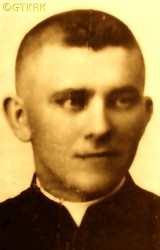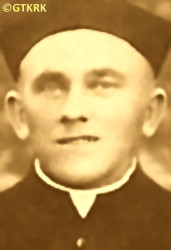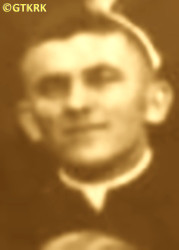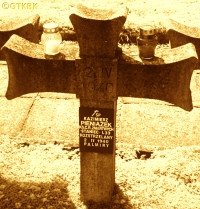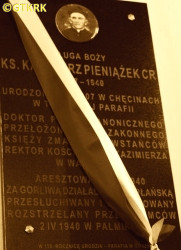Roman Catholic
St Sigismund parish
05-507 Słomczyn
85 Wiślana Str.
Konstancin deanery
Warsaw archdiocese, Poland
full list:
displayClick to display full list

searchClick to search full list by categories
wyświetlKliknij by wyświetlić pełną listę po polsku

szukajKliknij by przeszukać listę wg kategorii po polsku

Martyrology of the clergy — Poland
XX century (1914 – 1989)
personal data
religious status
Servant of God
surname
PIENIĄŻEK
forename(s)
Casimir (pl. Kazimierz)
function
religious cleric
creed
Latin (Roman Catholic) Church RCmore on
en.wikipedia.org
[access: 2014.09.21]
congregation
Congregation of the Resurrection of Our Lord Jesus Christ CRmore on
en.wikipedia.org
[access: 2013.05.19]
(i.e. Resurrectionist Fathers)
academic distinctions
Doctor of Canon Law
Bachelor of Theology
date and place
of death
02.04.1940

Palmirytoday: Czosnów gm., Nowy Dwór Mazowiecki pov., Masovia voiv., Poland
more on
en.wikipedia.org
[access: 2022.01.28]
details of death
After German and Russian invasion of Poland in 09.1939 and start of the World War II, after start of German occupation, arrested by the Germans on 17.01.1940 in Warsaw, during a search of his Congregation's house premises — refused to hand in to the Germans the funds collected for construction of a new church.
Held at an arrest at Rakowiecka Str. and Pawiak prison.
Beaten and tortured.
Next on c. 25.03.1940 transported to Modlin fortress — prob. to KL Pomiechówek Fort III concentration camp or a transit camp in fortress' Fort I founded there.
From there taken to an execution site in Palmiry n. Warsaw and murdered.
cause of death
mass murder
perpetrators
Germans
sites and events
PalmiryClick to display the description, KL Pomiechówek Fort IIIClick to display the description, PawiakClick to display the description, Warsaw (Mokotów)Click to display the description, «Intelligenzaktion»Click to display the description, GeneralgouvernementClick to display the description, Regierungsbezirk ZichenauClick to display the description, Ribbentrop‐MolotovClick to display the description, Pius XI's encyclicalsClick to display the description
date and place
of birth
04.03.1907

Chęcinytoday: Górzno gm., Garwolin pov., Masovia voiv., Poland
more on
en.wikipedia.org
[access: 2022.01.28]
parents
PIENIĄŻEK Michael
🞲 ?, ? — 🕆 1948, ?

ROGAL Marianne
🞲 ?, ? — 🕆 1975, ?
baptism
10.03.1907

Górznotoday: Górzno gm., Garwolin pov., Masovia voiv., Poland
more on
en.wikipedia.org
[access: 2021.12.18]
Nativity of St John the Baptist RC church
religious vows
08.03.1927 (temporary)
08.03.1930 (permanent)
presbyter (holy orders)
ordination
10.06.1933

Lvivtoday: Lviv urban hrom., Lviv rai., Lviv obl., Ukraine
more on
en.wikipedia.org
[access: 2022.01.16]
Our Lord's Resurrection RC churchmore on
pl.wikipedia.org
[access: 2023.08.31]
positions held
1938 – 1940
superior of the Congregation's house and rector of the church — Warsawtoday: Warsaw city pov., Masovia voiv., Poland
more on
en.wikipedia.org
[access: 2021.10.09] ⋄ Congregation's house (at 21A Chełmska Str.), Resurrectionists CR ⋄ St Casimir RC church ⋄ Warsaw‐in‐urbedeanery name
today: Warsaw city pov., Masovia voiv., Poland RC deanery
1937 – 1938
friar — Warsawtoday: Warsaw city pov., Masovia voiv., Poland
more on
en.wikipedia.org
[access: 2021.10.09] ⋄ Congregation's house (at 21A Chełmska Str.), Resurrectionists CR ⋄ St Casimir RC church ⋄ Warsaw‐in‐urbedeanery name
today: Warsaw city pov., Masovia voiv., Poland RC deanery — treasury officer / procurator of the Congregation's house and rectory church
1934 – 1937
PhD student — Rometoday: Rome prov., Lazio reg., Italy
more on
en.wikipedia.org
[access: 2021.12.18] ⋄ canon law, „Gregorianum” [i.e. Lat. Pontificia Universitas Gregoriana (Eng. Pontifical Gregorian University)] — PhD thesis Lat. „De patrimonio Ecclesiae in Polonia iuxta concordatum ex Anno 1925” (Eng. „Properties of the Church in Poland according to the concordat of 1925”); also a batchelor degree in theology, deputy director of the seminary (house of studies) at the Generalate in Via di San Sebastianello, assistant to the novice master (1936‐1937)
1933 – 1934
student — Lvivtoday: Lviv urban hrom., Lviv rai., Lviv obl., Ukraine
more on
en.wikipedia.org
[access: 2022.01.16] ⋄ canon law, Department of Theology, John Casimir University [i.e. clandestine John Casimir University (1941‐1944) / Ivan Franko University (1940‐1941) / John Casimir University (1919‐1939) / Franciscan University (1817‐1918)] — postgraduate specialised studies, crowned on 16.06.1934 with the title of Master of Sacred Theology in moral theology; also: resident and chronicler of the Congregation's house the Resurrection of the Lord Jesus church, 59 Piekarska Str., and vice–principal of the boarding hall
1931 – 1933
student — Lvivtoday: Lviv urban hrom., Lviv rai., Lviv obl., Ukraine
more on
en.wikipedia.org
[access: 2022.01.16] ⋄ philosophy and theology, Department of Theology, John Casimir University [i.e. clandestine John Casimir University (1941‐1944) / Ivan Franko University (1940‐1941) / John Casimir University (1919‐1939) / Franciscan University (1817‐1918)] — resident of the House of Study in the Congregation's house by the Resurrection of the Lord Jesus church, 59 Piekarska Str.; also: vice–prefect of the seminary students (1932‐1933)
1928 – 1931
friar — Lvivtoday: Lviv urban hrom., Lviv rai., Lviv obl., Ukraine
more on
en.wikipedia.org
[access: 2022.01.16] ⋄ Congregation's house (by the Resurrection of the Lord Jesus church, 59 Piekarska Str.), Resurrectionists CR — completion of education at the gymnasium level, crowned with the matura exam on 21.05.1931, passed in the Hetman Stanislav Żółkiewski's 5th State Gymnasium im.; also: senior in boarding school for boys (1930‐1931)
1926 – 1927
novitiate — Krakówtoday: Kraków city pov., Lesser Poland voiv., Poland
more on
en.wikipedia.org
[access: 2021.06.07] ⋄ Private Philosphy and Theology Study /till 1901 at 17‐19 St Philip Str. (Kleparz), from 1901 at 4 Stradomska Str. (Stradom)/ (at 8 Łobzowska Str.), Resurrectionists CR
21.09.1925
accession — Lvivtoday: Lviv urban hrom., Lviv rai., Lviv obl., Ukraine
more on
en.wikipedia.org
[access: 2022.01.16] ⋄ Congregation's house (by the Resurrection of the Lord Jesus church, 59 Piekarska Str.), Resurrectionists CR
others related
in death
KRAWCZYKClick to display biography John Ignatius, MĘŻYŃSKIClick to display biography Francis, NOWAKOWSKIClick to display biography Marcel Vaclav, SAJNAClick to display biography Sigismund Joseph
sites and events
descriptions
Palmiry: From 12.1939 till 07.1941 Germany — units of genocidal SS and Germ. Schutzpolizei (Eng. preventive police), i.e. Schupo —‐ in mass executions, murdered in Palmiry c. 1,700‐2,200 Poles from Warsaw, mainly the intelligentsia, as part of the «AB‐aktion», as well as Jews. The first executions took place on December 07‐08.12.1939 (70+80 victims). Among the biggest were: 26.02.1940 — c. 190 people; 02.04.1940 — c. 100. The victims were brought to the execution site by trucks, usually at dawn. Their luggage was collected at the site. Sometimes were restrained and/or blindfolded. Next were led to the edge of the dug pits where they were shot with machine gun fire. Those giving signs of life were finished off with small arms. The pits were filled in and pine thickets planted. (more on: en.wikipedia.orgClick to attempt to display webpage
[access: 2022.08.17])
KL Pomiechówek Fort III: German Germ. Konzentrationslager (Eng. concentration camp) KL — formally known as Germ. Polizei Gefängnis (Eng. police prison), but also Germ. Todeslager (Eng. death camp, torture camp) or Germ. Durchgangslager (Eng. transit camp) — set‐up by Germans in military forts of Fortress Modlin n. Warsaw, largest in German occupied northern Masovia, in Germ. Regierungsbezirk Zichenau (Eng. Ciechanów Regency), part of German province Germ. Ostpreußen (Eng. East Prussia), where German state law was in force. In 1941‐1944 from 50,000 to 100,000 prisoners were held there, in atrocious conditions, mainly Poles, members of clandestine resistance organizations (part of Polish Clandestine State), but also Jews (till 1943). Thousands were murdered (including c. 6,000‐10,000 of Jews) — an unambiguous determination of the number of murdered is impossible, for from the beginning of 1944 the Germans started to wipe out the traces of the crimes. During camp closure Germans murdered all remaining inmates (apart from c. 25 women). (more on: www.dolinawkry.c0.plClick to attempt to display webpage
[access: 2013.08.17], pl.wikipedia.orgClick to attempt to display webpage
[access: 2013.06.23])
Pawiak: Investigative prison in Warsaw, built by the Russian occupiers of Poland in 1830‐1835. During the Poland partition's period, a Russian investigative prison, both criminal and political. During World War II and the German occupation, the largest German prison in the Germ. Generalgouvernement (Eng. General Governorate). Initially, it was subordinate to the Justice Department of the General Governorate, and from 03.1940 Germ. Sicherheitspolizei und des Sicherheitsdienst (Eng. Security Police and Security Service) of the Warsaw District — in particular the German Secret Political Police Gestapo. c. 3,000 prisoners were kept in Pawiak permanently, of which about 2,200 in the men's unit and c. 800 in the women's unit (the so‐called Serbia) — with a „capacity” of c. 1,000 prisoners. In total, in the years 1939‐1944, c. 100,000 Poles passed through the prison, of which c. 37,000 were murdered in executions — from 10.1943 Pawiak prisoners were murdered in open executions on the streets of Warsaw (sometimes several times a day) — during interrogations, in cells or in a prison „hospital”, and c. 60,000 were taken in 95 transports to concentration camps (mainly KL Auischwitz), other places of isolation or to forced labor. The prison Germans demolished during the Warsaw Uprising in 08‐10.1944. (more on: en.wikipedia.orgClick to attempt to display webpage
[access: 2022.08.17])
Warsaw (Mokotów): Prison and detention centre in Warsaw on Rakowiecka Str. Used by Germans during German occupation 1939‐1945 to held thousands of Poles. In 1945‐1956 thousands of Polish independence activists were held there by the Polish Commie‐Nazi branch of Russian NKVD/KGB police. Hundreds of Poles were executed. (more on: pl.wikipedia.orgClick to attempt to display webpage
[access: 2013.08.17])
«Intelligenzaktion»: German: «Intelligenzaktion» (English: „Intelligence Action”) — a German program of extermination of the Polish elite, mainly the intelligentsia and leadership layers, carried out from the beginning of the occupation in w 09.1939 to 04.1940, mainly in territories directly annexed to Germany, but also in the so‐called Germ. Generalgouvernement (Eng. General Governorate), where it was called «AB‐aktion». In the first phase, immediately after the beginning of the German occupation, during military operations carried out by the Germ. Wehrmacht (Eng. Armed Forces) and the genocidal units of the Germ. Einsatzgruppen (Eng. Operational Groups) of the Germ. Sicherheitspolizei (Eng. Security Police), i.e. SiPo, and Germ. Sicherheitsdienst des Reichsführers SS (Eng. Security Service of the Reichsführer SS), i.e. SD, organized by the Germ. Reichssicherheitshauptamt (Eng. Reich Main Security Office), i.e. RSHA, which followed the troops, carried out under the Germ. Unternehmen „Tannenberg” (Eng. Operation „Tannenberg”) — based on the so‐called Germ. Sonderfahndungsliste (Eng. Special Wanted Lists), i.e. proscription lists of Poles considered particularly dangerous to the Third Reich, prepared by the Zentralstelle II/P (Polen) unit of the German RSHA. Later, implemented by the German civilian occupation authorities and the genocidal unit of the Germ. Volksdeutscher Selbstschutz (Eng. Ethnic Germans Self‐Defense), whose members were Germ. Volksdeutsche (Eng. Ethnic Germans), i.e. representatives of the German minority in Poland. According to various sources, these lists, at the beginning of 09.1939, could have contained the details of 61,000—88,000 „dangerous” Poles — although these figures cannot be confirmed. In total, during this genocide, c. 50,000 teachers, Catholic priests, representatives of the landed gentry, freelancers, social and political activists, and retired military personnel were systematically and methodically murdered. Another 50,000 were sent to concentration camps, where only a negligible percentage survived. (more on: en.wikipedia.orgClick to attempt to display webpage
[access: 2014.10.04])
Generalgouvernement: After the Polish defeat in the 09.1939 campaign, which was the result of the Ribbentrop‐Molotov Pact and constituted the first stage of World War II, and the beginning of German occupation in part of Poland (in the other, eastern part of Poland, the Russian occupation began), the Germans divided the occupied Polish territory into five main regions. In two of them new German provinces were created, two other were incorporated into other provinces. However, the fifth part was treated separately, and in a political sense it was supposed to recreate the German idea from 1915 (during World War I, after the defeat of the Russians in the Battle of Gorlice in 05.1915) of creating a Polish enclave within Germany. Illegal in the sense of international law, i.e. Hague Convention, and public law, managed by the Germans according to separate laws — especially established for the Polish Germ. Untermenschen (Eng. subhumans) — till the Russian offensive in 1945 it constituted part of the Germ. Großdeutschland (Eng. Greater Germany). Till 31.07.1940 formally called Germ. Generalgouvernement für die besetzten polnischen Gebiete (Eng. General Government for the occupied Polish lands) — later simply Germ. Generalgouvernement (Eng. General Governorate), as in the years 1915‐1918. From 07.1941, i.e. after the German attack on 22.06.1941 against the erstwhile ally, the Russians, it also included the Galicia district, i.e. the Polish pre‐war south‐eastern voivodeships. A special criminal law was enacted and applied to Poles and Jews, allowing for the arbitrary administration of the death penalty regardless of the age of the „perpetrator”, and sanctioning the use of collective responsibility. After the end of the military conflict of the World War UU, the government of the Germ. Generalgouvernement was recognized as a criminal organization, and its leader, governor Hans Frank, guilty of war crimes and crimes against humanity and executed. (more on: en.wikipedia.orgClick to attempt to display webpage
[access: 2024.12.13])
Regierungsbezirk Zichenau: After the Polish defeat in the 09.1939 campaign, which was the result of the Ribbentrop‐Molotov Pact and constituted the first stage of World War II, and the beginning of German occupation in part of Poland (in the other, eastern part of Poland, the Russian occupation began), the Germans divided the occupied Polish territory into five main regions (and a few smaller). The largest one was transformed into Germ. Generalgouvernement (Eng. General Governorate), intended exclusively for Poles and Jews and constituting part of the so‐called Germ. Großdeutschland (Eng. Greater Germany). From two separate new provinces were created. The two remaining were incorporated into existing German provinces. One of those was the Germ. Regierungsbezirk Zichenau (Eng. Ciechanów regency), created from part of the occupied Warsaw voivodeship, and incorporated into the Germ. Provinz Ostpreußen (Eng. East Prussia) — on the basis of the decree of the German leader Adolf Hitler of 08.10.1939 (formally in force from 26.10.1939) — in which the law of the German state was applicable. The main axis of the policy of the new regency, the territory of which the Germans recognized as the Germ. „Ursprünglich Deutsche” (Eng. „natively German”), despite the fact only 6% of its pre–war Polish part were Germans, was Germ. „Entpolonisierung” (Eng. „Depolonisation”), i.e. forced Germanization, and Germ. Zwangsarbeit (Eng. forced slave labor). Most of the Germ. Zivilarbeiter (Eng. civilian worker) slaved in the Germ. Provinz Ostpreußen. Some Poles— c. 25,000 — were deported to the Germ. Generalgouvernement; some were sent to concentration camps. Children could only learn in German. A policy of terror was pursued against the Polish population — 8 large prisons operated in a small area, Polish organizations and institutions were closed. The Polish press was liquidated. Of the 200 arrested Catholic priests from the Płock diocese, 110 were murdered. Most parishes were left without pastors — only a few priests per county were allowed to serve. Conducting services, sermons and confessions in Polish was prohibited. Churches were plundered and turned into warehouses. Catholic funerals with more than 10 people were prohibited. Crosses, roadside shrines, tombstones and cemeteries were destroyed. After the end of hostilities of World War II, the overseer of this province, the Germ. Reichsstatthalter (Eng. Reich Governor) and the Germ. Gauleiter (Eng. district head) of the German National Socialist Party, Erich Koch, initially went into hiding, then was captured and extradited to the Commie–Nazi republic of Poland prl, sentenced to death, but the sentence was not carried out and died in prison in 1986. The Germ. Regierungspräsidenten Zichenau (Eng. superpresident of the Ciechanów regency) hid better and his post‐war fate is still unknown. (more on: en.wikipedia.orgClick to attempt to display webpage
[access: 2024.06.24])
Ribbentrop‐Molotov: Genocidal Russian‐German alliance pact between Russian leader Joseph Stalin and German leader Adolf Hitler signed on 23.08.1939 in Moscow by respective foreign ministers, Mr. Vyacheslav Molotov for Russia and Joachim von Ribbentrop for Germany. The pact sanctioned and was the direct cause of joint Russian and German invasion of Poland and the outbreak of the World War II in 09.1939. In a political sense, the pact was an attempt to restore the status quo ante before 1914, with one exception, namely the „commercial” exchange of the so‐called „Kingdom of Poland”, which in 1914 was part of the Russian Empire, fore Eastern Galicia (today's western Ukraine), in 1914 belonging to the Austro‐Hungarian Empire. Galicia, including Lviv, was to be taken over by the Russians, the „Kingdom of Poland” — under the name of the General Governorate — Germany. The resultant „war was one of the greatest calamities and dramas of humanity in history, for two atheistic and anti‐Christian ideologies — national and international socialism — rejected God and His fifth Decalogue commandment: Thou shall not kill!” (Abp Stanislav Gądecki, 01.09.2019). The decisions taken — backed up by the betrayal of the formal allies of Poland, France and Germany, which on 12.09.1939, at a joint conference in Abbeville, decided not to provide aid to attacked Poland and not to take military action against Germany (a clear breach of treaty obligations with Poland) — were on 28.09.1939 slightly altered and made more precise when a treaty on „German‐Russian boundaries and friendship” was agreed by the same murderous signatories. One of its findings was establishment of spheres of influence in Central and Eastern Europe and in consequence IV partition of Poland. In one of its secret annexes agreed, that: „the Signatories will not tolerate on its respective territories any Polish propaganda that affects the territory of the other Side. On their respective territories they will suppress all such propaganda and inform each other of the measures taken to accomplish it”. The agreements resulted in a series of meeting between two genocidal organization representing both sides — German Gestapo and Russian NKVD when coordination of efforts to exterminate Polish intelligentsia and Polish leading classes (in Germany called «Intelligenzaktion», in Russia took the form of Katyń massacres) where discussed. Resulted in deaths of hundreds of thousands of Polish intelligentsia, including thousands of priests presented here, and tens of millions of ordinary people,. The results of this Russian‐German pact lasted till 1989 and are still in evidence even today. (more on: en.wikipedia.orgClick to attempt to display webpage
[access: 2015.09.30])
Pius XI's encyclicals: Facing the creation of two totalitarian systems in Europe, which seemed to compete with each other, though there were more similarities than contradictions between them, Pope Pius XI issued in 03.1937 (within 5 days) two encyclicals. In the „Mit brennender Sorge” (Eng. „With Burning Concern”) published on 14.03.1938, condemned the national socialism prevailing in Germany. The Pope wrote: „Whoever, following the old Germanic‐pre‐Christian beliefs, puts various impersonal fate in the place of a personal God, denies the wisdom of God and Providence […], whoever exalts earthly values: race or nation, or state, or state system, representatives of state power or other fundamental values of human society, […] and makes them the highest standard of all values, including religious ones, and idolizes them, this one […] is far from true faith in God and from a worldview corresponding to such faith”. On 19.03.1937, published „Divini Redemptoris” (Eng. „Divine Redeemer”), in which criticized Russian communism, dialectical materialism and the class struggle theory. The Pope wrote: „Communism deprives man of freedom, and therefore the spiritual basis of all life norms. It deprives the human person of all his dignity and any moral support with which he could resist the onslaught of blind passions […] This is the new gospel that Bolshevik and godless communism preaches as a message of salvation and redemption of humanity”… Pius XI demanded that the established human law be subjected to the natural law of God , recommended the implementation of the ideal of a Christian state and society, and called on Catholics to resist. Two years later, National Socialist Germany and Communist Russia came together and started World War II. (more on: www.vatican.vaClick to attempt to display webpage
[access: 2023.05.28], www.vatican.vaClick to attempt to display webpage
[access: 2023.05.28])
sources
personal:
www.meczennicy.pelplin.plClick to attempt to display webpage
[access: 2012.11.23], www.hagiographycircle.comClick to attempt to display webpage
[access: 2012.11.23], diecezja.siedlce.plClick to attempt to display webpage
[access: 2019.10.13], www.straty.plClick to attempt to display webpage
[access: 2019.04.16]
original images:
diecezja.siedlce.plClick to attempt to display webpage
[access: 2019.10.13], diecezja.siedlce.plClick to attempt to display webpage
[access: 2019.10.13], diecezja.siedlce.plClick to attempt to display webpage
[access: 2019.10.13], diecezja.siedlce.plClick to attempt to display webpage
[access: 2019.10.13], podlasie24.plClick to attempt to display webpage
[access: 2019.10.13], diecezja.siedlce.plClick to attempt to display webpage
[access: 2019.10.13]
LETTER to CUSTODIAN/ADMINISTRATOR
If you have an Email client on your communicator/computer — such as Mozilla Thunderbird, Windows Mail or Microsoft Outlook, described at WikipediaPatrz:
en.wikipedia.org, among others — try the link below, please:
LETTER to CUSTODIAN/ADMINISTRATORClick and try to call your own Email client
If however you do not run such a client or the above link is not active please send an email to the Custodian/Administrator using your account — in your customary email/correspondence engine — at the following address:

giving the following as the subject:
MARTYROLOGY: PIENIĄŻEK Casimir
To return to the biography press below:
 Click to return to biography
Click to return to biography








